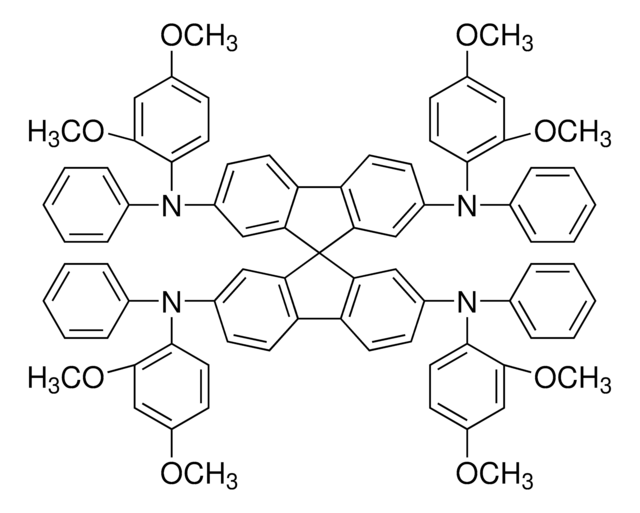推荐产品
化驗
99% (HPLC)
形狀
solid
環保替代產品特色
Design for Energy Efficiency
Learn more about the Principles of Green Chemistry.
sustainability
Greener Alternative Product
mp
243-248 °C
λmax
306 nm in dichloromethane
385 nm in dichloromethane
螢光
λem 429 nm in dichloromethane
環保替代類別
, Enabling
SMILES 字串
COC(C=C1)=CC=C1N(C2=CC=C(C=C2)OC)C(C=C3)=CC4=C3C(C=CC(N(C5=CC=C(C=C5)OC)C6=CC=C(C=C6)OC)=C7)=C7C84C9=C(C=CC(N(C%10=CC=C(C=C%10)OC)C%11=CC=C(C=C%11)OC)=C9)C%12=C8C=C(N(C%13=CC=C(C=C%13)OC)C%14=CC=C(C=C%14)OC)C=C%12
InChI
1S/C81H68N4O8/c1-86-65-29-9-53(10-30-65)82(54-11-31-66(87-2)32-12-54)61-25-45-73-74-46-26-62(83(55-13-33-67(88-3)34-14-55)56-15-35-68(89-4)36-16-56)50-78(74)81(77(73)49-61)79-51-63(84(57-17-37-69(90-5)38-18-57)58-19-39-70(91-6)40-20-58)27-47-75(79)76-48-28-64(52-80(76)81)85(59-21-41-71(92-7)42-22-59)60-23-43-72(93-8)44-24-60/h9-52H,1-8H3
InChI 密鑰
XDXWNHPWWKGTKO-UHFFFAOYSA-N
相关类别
一般說明
應用
儲存類別代碼
11 - Combustible Solids
水污染物質分類(WGK)
WGK 3
閃點(°F)
Not applicable
閃點(°C)
Not applicable
其他客户在看
商品
Solar panels for homes and businesses have seen a rise in demand over the past few years as we move toward more environment-friendly and sustainable energy sources. In 2010, the average power from solar was just 5.0 GWh/d and the Energy Information Administration (EIA) expects this to be 90 GWh/d in 2016.
While dye sensitization as the basis for color photography has been accepted for a very long time,1 attempts to use this principle for the conversion of solar light to electricity generally had resulted only in very low photocurrents, below 100 nA/cm2.2
Advances in the area of soft optoelectronics, with a focus on the development of organic optoelectronic devices on shape memory polymers (SMP) is discussed.
Next generation solar cells have the potential to achieve conversion efficiencies beyond the Shockley-Queisser (S-Q) limit while also significantly lowering production costs.
相关内容
Organic electronics utilizes organic conductors and semiconductors for applications in organic photovoltaics, organic light-emitting diodes, and organic field-effect transistors.
Organic electronics utilizes organic conductors and semiconductors for applications in organic photovoltaics, organic light-emitting diodes, and organic field-effect transistors.
我们的科学家团队拥有各种研究领域经验,包括生命科学、材料科学、化学合成、色谱、分析及许多其他领域.
联系技术服务部门


![聚[双(4-苯基)(2,4,6-三甲基苯基)胺] a poly(triaryl amine) semiconductor](/deepweb/assets/sigmaaldrich/product/structures/122/933/c34a34ab-284f-4890-adb8-126247a91d9b/640/c34a34ab-284f-4890-adb8-126247a91d9b.png)






